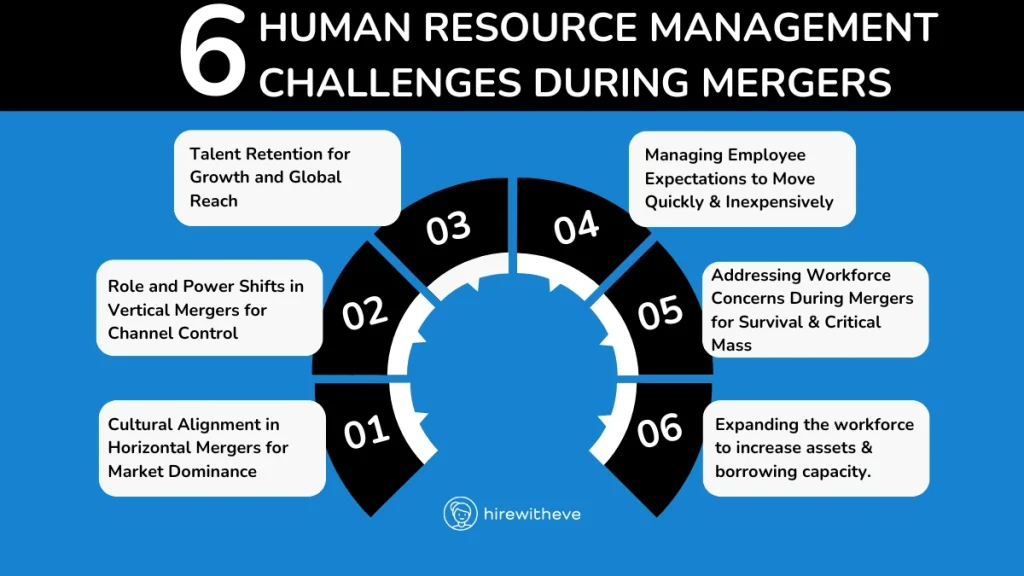6 Human Resource Management Challenges During Mergers and How to Overcome

Mergers and acquisitions (M&A) are an integral part of business growth and expansion strategies. They can bring about transformative changes that allow organizations to capture new markets, optimize operations, and improve profitability. However, despite their strategic importance, one of the most overlooked yet critical areas in this process is managing the workforce.
Human resource management challenges during mergers are among the most complex and impactful hurdles that HR professionals and talent acquisition specialists face. Successfully navigating these challenges is essential for ensuring the smooth transition of both companies involved.
This blog delves into the human resource management challenges during mergers, focusing on the role of HR managers in managing people-related issues. Whether dealing with cultural integration, handling redundancies, or maintaining morale, these challenges require a robust HR strategy.
We will explore key insights from industry surveys and provide practical solutions to ensure the transition is seamless.
Some Survey and Industry Insights
Several industry reports have examined the impact of human resource management during mergers. According to a survey conducted by Deloitte, more than 50% of failed mergers cite poor handling of human resources as a key reason for failure. The same survey also highlights that human resource management challenges during mergers tend to escalate when there is a lack of transparency and ineffective communication.
In another study by PwC, 70% of employees expressed that uncertainty during mergers led to reduced job satisfaction, and 65% felt that the company’s culture was negatively impacted. The study emphasized that human resource management challenges during mergers are particularly pronounced when it comes to maintaining employee engagement and addressing conflicts between differing corporate cultures.
6 Human Resource Management Challenges During Mergers
Here are some major challenges for human resource management during mergers and acquisitions:

Cultural Alignment in Horizontal Mergers for Market Dominance
Horizontal mergers, where two companies in the same industry join forces to dominate the market, often pose significant challenges in terms of cultural alignment. As both companies may have similar business models but different work cultures, HR managers need to focus on creating a cohesive culture that supports the goal of market dominance. Ensuring employees from both organizations are aligned with the new company vision is crucial to achieving economies of scale and improving operational efficiency.
Role and Power Shifts in Vertical Mergers for Channel Control
Vertical mergers, which involve companies at different stages of the supply chain, bring about a unique set of human resource challenges, particularly in terms of restructuring roles and control. In these mergers, HR must manage shifts in employee responsibilities, power dynamics, and integration of operations. HR managers should focus on role clarification and ensure that employees are comfortable with their new place in the organizational hierarchy, which helps establish effective channel control.
Talent Retention for Growth and Global Reach
When a merger is driven by the goal of achieving global reach and world-class leadership, retaining top talent is essential. HR managers need to ensure that the company can quickly scale operations without losing key employees who are vital to its expansion strategy. To achieve this, HR can offer talent retention programs, professional development opportunities, and clear career growth paths that align with the company’s global ambitions.
Managing Employee Expectations to Move Quickly and Inexpensively
One of the core objectives of many mergers is to execute the integration process quickly and cost-effectively. However, moving too fast can create anxiety among employees who may feel overwhelmed by the pace of change. HR teams must balance speed with effective communication to manage expectations and ensure that employees understand the rationale behind the quick transition, which can prevent resistance and turnover.
Addressing Workforce Concerns During Mergers for Survival and Critical Mass
Mergers driven by the need for survival or achieving critical mass often involve difficult decisions, such as layoffs or resource consolidation. HR professionals face the challenge of maintaining employee morale during uncertain times while making tough decisions about redundancies. Transparent communication and providing support to affected employees can help ease the transition and preserve the company’s reputation.
Expanding the workforce to increase assets and borrowing capacity.
A larger asset base after a merger can improve a company’s borrowing power, but this also means that HR must manage a significantly larger workforce. This can be a challenge in terms of scaling HR processes and systems to manage the expanded employee base. HR can leverage technology and data analytics to manage talent efficiently, ensuring that the larger workforce is aligned with the company’s financial goals.
How Can HR Overcome These Challenges?
Successfully overcoming human resource management challenges during mergers requires a well-structured HR strategy that places employees at the center of the process.
Here are a few key solutions:
Align Cultures to Support Market Dominance
In horizontal mergers focused on market dominance, HR needs to take a proactive approach to cultural alignment. This can be achieved by conducting cultural audits, facilitating workshops, and encouraging cross-company collaboration to integrate different work styles. Aligning employees with the shared goal of market dominance is key to achieving economies of scale and fostering a unified company vision.
Clarify Roles for Effective Channel Control in Vertical Mergers
HR managers should prioritize clear communication of new roles and responsibilities when vertical mergers occur. By providing role clarity and offering training, HR can help employees adjust to their new positions, thus ensuring smooth integration across the supply chain and strengthening the company’s control over its channels.
Establish Global Talent Programs for World-Class Growth
In mergers aimed at global expansion, HR must ensure that the right talent is in place to support the company’s growth objectives. By developing global talent retention strategies and offering career development programs, HR can help the organization retain top talent, which is crucial for achieving world-class leadership and global reach.
Balance Speed with Employee Engagement
While it is essential to move quickly and inexpensively during mergers, HR managers must ensure that employees remain engaged throughout the process. By maintaining clear, consistent communication and providing support for employees during the transition, HR can help minimize disruptions and maintain productivity.
Provide Transparent Communication for Mergers Focused on Survival
In mergers driven by survival and the need for critical mass, HR should offer transparent communication and regular updates to keep employees informed and mitigate uncertainty. Providing support for employees affected by layoffs or role changes is essential for maintaining morale and ensuring a smooth transition.
Optimize HR Processes for Managing a Larger Workforce
Post-merger, the expanded asset base often results in a larger workforce. HR can overcome this challenge by leveraging technology platforms such as HirewithEve.ai to manage a larger employee pool effectively. Tools that streamline recruitment, performance management, and communication will help HR scale its processes to accommodate the larger organization while maximizing its borrowing capacity and financial stability.
Conclusion
Mergers present a unique set of challenges, particularly for HR managers and talent acquisition specialists tasked with integrating two distinct workforces. The human resource management challenges during mergers are significant, encompassing cultural integration, employee uncertainty, communication issues, talent retention, and redundancy management.
However, with the right strategies and tools in place, these challenges can be successfully navigated to ensure a smooth transition.
By leveraging technology and prioritizing transparent communication, HR professionals can address the key human resource management challenges during mergers and create a unified, productive workforce in the post-merger organization.
Platforms like HirewithEve.ai can further assist by providing the tools necessary to streamline talent management and support a successful merger process.
